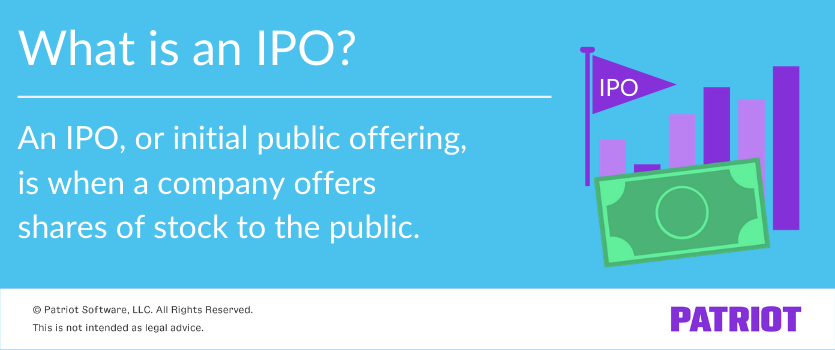If your business is private, at some point or another you may consider going public. When you go public, you go through an IPO process. So, what is an IPO? Read on to learn the ins and outs of an IPO, what the process entails, and the pros and cons of going public.
What is an IPO?
An IPO, or initial public offering, is when a company offers shares of stock to the public. The first set of stocks the company offers for sale to the public is the initial public offering. As mentioned, IPO is often referred to as “going public.” When businesses decide to move forward with an IPO, they transition from a private to a public company.
An IPO allows business owners to give up part of their ownership to stockholders. This lets a business raise capital from public investors and puts ownership of the company in the hands of the public.
Before a company decides to have an IPO and go public, it typically goes through a period of growth. Many businesses decide to go public due to financial reasons. An IPO gives a business more access to cash, generally in large amounts. In turn, the company can use the money made through an IPO to pay off business debt, increase development, and expand the company.
Private companies vs. public companies
Private companies are generally small businesses (in terms of capital and owners) that are owned by a small or exclusive group of people. When you own a private company, you can keep most of your business information under wraps and out of public scrutiny. Many sole proprietorships and family corporations are private.
On the other hand, public companies are usually larger than private companies. They can have more owners and capital than smaller, privately owned businesses. When a company goes public, ownership of the business is open to the public, and people can buy stocks or shares of the public company.
Most public companies start out as private companies. A private company may decide to become a public company if it needs a large influx of funds to expand as a business.

Pros and cons of IPO
As a business owner, you need to determine if going public is worth it in the long run for your company. Before you make the big leap, weigh the advantages and disadvantages of IPO.
Pros
An initial public offering is exciting for small business owners. It means your company is in a good place and is roaring and ready to grow even more.
An IPO has many perks. It can:
- Generate more funds to expand and grow your business
- Help pay off debt
- Fund investments
- Attract top talent with employee equity options
- Enhance the company’s reputation and credibility
Going public can also be useful for mergers and acquisitions. If a business wants to acquire another business, it can use shares as a form of payment.
Cons
While it may be tempting to go public because of additional funds, there is some risk you need to be aware of before you decide to move forward with it.
The IPO process is not a piece of cake. It requires a lot of attention and hard work. As a business owner, you’re responsible for taking on the additional work and going through the IPO process. The process can also be expensive for small business owners. You will likely have to pay legal fees if you decide to go public. Plus, you have to pay ongoing costs for legal and financial reporting after you implement an IPO.
Every business that goes public runs the risk of stock performing poorly after the IPO. If the stock price falls below the IPO price, the IPO is considered “broken.” A broken IPO can get bad press and impact the business’s reputation in the marketplace.
Along with an in-depth process, regulators from the Securities and Exchange Commission (SEC) observe and examine a public company. Companies must meet SEC requirements to hold an initial public offering. Additionally, public companies must closely adhere to the Sarbanes-Oxley Act, which sets specific financial regulations for public companies.
When your company goes public, a lot of details about your business and its owners become public, too. This means a lot of valuable information about the company’s operations and finances is released to the public for anyone (including competitors) to see.
In short, there are a few cons you should keep on your radar before you go public. Ask yourself the following questions:
- Can I afford an IPO and the ongoing expenses associated with it?
- Am I willing to take the risk and potentially lose money?
- Will I be able to follow the laws and regulations?
- Am I OK with my business’s financial and operations information going public?
Initial public offering process
Again, going through an initial public offering process can be challenging. As a business owner, you need to follow a number of steps to go public. In most cases, the private company usually has to go through the following steps:
- Find an investment bank: The bank goes through an underwriting process and handles the IPO.
- Do due diligence and collect financial information: The IPO team (investment bank, accountant, lawyer, financial manager, etc.) assembles required financial information.
- Get approval from the SEC: The bank files a registration statement with the SEC, and the SEC will investigate the company’s application to go public.
- Set a date and create a prospectus: The investment bank sets a date for the IPO and creates a prospectus that details the financial information on the company.
- Come up with a price: The company and the bank underwriter determines an initial price for the IPO.
- Release the IPO: The company’s initial public offering is available to the public for purchase.
After the company officially goes public, the underwriters from the investment bank continue to provide estimates about the company’s earnings and updates about the IPO.
Are you looking for a better way to track your business’s money? With Patriot’s accounting software, you can access reports like profit and loss statements, balance sheets, and more. Start your free trial today!
This article has been updated from its original publication date of May 8, 2015.
This is not intended as legal advice; for more information, please click here.
